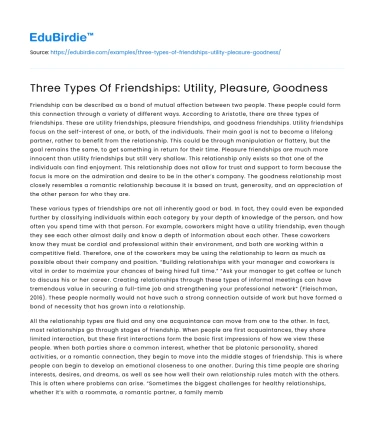Friendship can be described as a bond of mutual affection between two people. These people could form this connection through a variety of different ways. According to Aristotle, there are three types of friendships. These are utility friendships, pleasure friendships, and goodness friendships. Utility friendships focus on the self-interest of one, or both, of the individuals. Their main goal is not to become a lifelong partner, rather to benefit from the relationship. This could be through manipulation or flattery, but the goal remains the same, to get something in return for their time. Pleasure friendships are much more innocent than utility friendships but still very shallow. This relationship only exists so that one of the individuals can find enjoyment. This relationship does not allow for trust and support to form because the focus is more on the admiration and desire to be in the other’s company. The goodness relationship most closely resembles a romantic relationship because it is based on trust, generosity, and an appreciation of the other person for who they are.
These various types of friendships are not all inherently good or bad. In fact, they could even be expanded further by classifying individuals within each category by your depth of knowledge of the person, and how often you spend time with that person. For example, coworkers might have a utility friendship, even though they see each other almost daily and know a depth of information about each other. These coworkers know they must be cordial and professional within their environment, and both are working within a competitive field. Therefore, one of the coworkers may be using the relationship to learn as much as possible about their company and position. “Building relationships with your manager and coworkers is vital in order to maximize your chances of being hired full time.” ”Ask your manager to get coffee or lunch to discuss his or her career. Creating relationships through these types of informal meetings can have tremendous value in securing a full-time job and strengthening your professional network” (Fleischman, 2016). These people normally would not have such a strong connection outside of work but have formed a bond of necessity that has grown into a relationship.
Save your time!
We can take care of your essay
- Proper editing and formatting
- Free revision, title page, and bibliography
- Flexible prices and money-back guarantee
All the relationship types are fluid and any one acquaintance can move from one to the other. In fact, most relationships go through stages of friendship. When people are first acquaintances, they share limited interaction, but these first interactions form the basic first impressions of how we view these people. When both parties share a common interest, whether that be platonic personality, shared activities, or a romantic connection, they begin to move into the middle stages of friendship. This is where people can begin to develop an emotional closeness to one another. During this time people are sharing interests, desires, and dreams, as well as see how well their own relationship rules match with the others. This is often where problems can arise. “Sometimes the biggest challenges for healthy relationships, whether it’s with a roommate, a romantic partner, a family member, or a professor, are different communication styles and unclear expectations” (Quinn-Szcesuil, 2013). This communication breakdown can lead a friendship to fall apart and people need to be mindful that they are being honest with the other people and airing their grievances. This gives the other party the opportunity to have an open dialogue and resolve the conflict before it becomes too much to deal with.






 Stuck on your essay?
Stuck on your essay?

